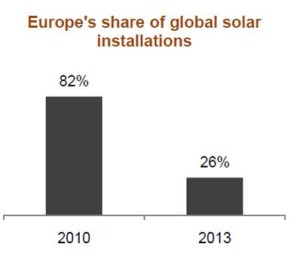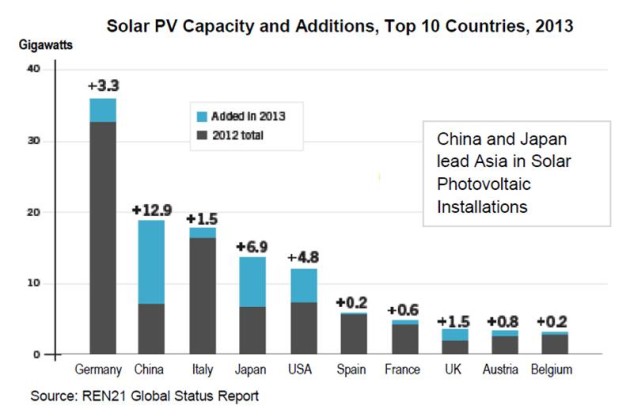Summary of Developments in Solar Energy Sector Across the World
Although India is yet to catch up, leaders like Germany, US, China and Japan have provided a base for a thriving solar power industry. Global installed capacity crossed 140 GW last year and is expected to perform better this year. With the right policy support, solar power can help countries diversify their energy mix and develop a sustainable source of power for the long term.
Developments in Solar Energy across the World
 EUROPE – TRADITIONAL CENTRE OF DEMAND
EUROPE – TRADITIONAL CENTRE OF DEMAND
Europe continues to have the largest solar PV capacity amongst all regions, reaching 80 GW by end of the year 2013. In the last decade, Governments promoted solar power through Feed-in-Tariffs, Reverse Auctions and Tradable Green Certificates, ensuring attractive returns to investors. However faced with adverse economic conditions, most EU markets have slowed down significantly. Retroactive taxes in some countries and a general weakening of support from Governments have led to reduction in Europe’s share of total capacity additions. Still, Europe continues to be a significant market, with close to 11 GW installed in 2013.
Europe provided the stepping stone for solar power to become a widely adopted source of power today.
Germany leads the region in installed capacity base (36 GW) as well as new capacity (3.5 GW). Attractive Feed in Tariffs have encouraged on-site solar power that now contributes to a third of total capacity.
The UK is the newest strong entrant in the market, adding 1.5 GW in 2013. The Government is planning to shift focus from large grid connected projects to on-site generation. Italy, Romania and Greece were other significant markets, adding approximately 4 GW last year.
ASIA – THE NEW GROWTH FRONTIER
In sharp contrast to Europe, Asia has added significant capacity, and is home to 30% of the world’s solar PV capacity today. Out of the 23 GW added by Asia in 2013, China alone accounted for 13 GW, with Japan following at 7 GW. These two countries now have 80% of installed solar PV capacity in Asia. India is yet to achieve such rapid growth despite its huge size and growing electricity demand – it is hoped that the sector will get an extra push from the Government this year.

Rising Asian Giants
With its rapid strides in adopting solar power, China today has the second largest solar power capacity in the world at approximately 20 GW. It however remains to be seen how effectively this power is evacuated with existing infrastructure. Japan ranks next only to China with 13.5 GW installed till date. It is laying special emphasis on rooftop solar to diversify its energy mix. India, Korea and Thailand made moderate progress, installing 2 GW amongst them in 2013.
OVERCOMING CHALLENGES
The last two years have been tough for most manufacturers who have faced the challenge of oversupply and falling margins. With improvement in the demand supply balance, the industry has been able to recover although consolidation continues. C-SI Module prices stabilized by the end of 2013 driven by growth in demand from leading markets of China, Japan and USA. Module manufacturing capacity still far exceeds demand – production capacity reached 68 GW by end of 2013, compared to production of 47 GW during the year. China continues to be the centre of production with two thirds of production. Europe and North America now account for only 15% of global production. In India, manufacturers have faced challenges of lack of scale, but have been helped somewhat by local content requirements.
Top Module and Inverter manufacturers;
| Rank | Module Manufacturers | Inverter Manufacturers |
| 1 | Yingli | SMA |
| 2 | Trina Solar | ABB |
| 3 | Sharp | Omron |
| 4 | Canadian Solar | TMEIC |
| 5 | Jinko Solar | Sungrow |
| 6 | ReneSola | Advanced Energy |
| 7 | First Solar | Tabuchi |
| 8 | Hanwha | Schneider |
| 9 | Kyocera | Enphase |
| 10 | JA Solar | KACO |
Source: Solar Buzz, IHS
DEVELOPMENT AND INNOVATION
Challenges arising from oversupply have forced the industry to innovate. While work continues on improving solar cell efficiencies, companies have adapted through operational improvements and strategic changes also.
Turnkey Solutions
Many manufacturers are now placing more emphasis on downstream activities like project development and operations and maintenance. In countries like India, consumers look for turn-key solutions rather than put together various components themselves. Companies have responded positively by introducing sale of projects in solar parks for example.
Rooftop Solar
While Germany provided the initial boost to rooftop solar power, the USA and Japan are now leading the initiative with special focus on this area. Supportive policies in the form of attractive feed in tariffs and net metering have led to large scale adoption of rooftop solar – a true democratization of power generation.
ROLE OF GOVERNMENT AND POLICY
Solar power has succeeded in transforming itself from an experimental technology to a widely adopted and reliable source of energy. Countries that have been most successful in using solar power to diversify their energy mix are those that have actively given policy support for it. The growth of renewable energy brings along a number of administrative challenges –
- the need to balance low tariffs with sustainable growth
- the need to provide a supportive environment to distributed generation
- the need to adopt new technologies like grid scale storage and smart grids along with reduction in commercial losses
The support of Governments is therefore crucial to having a modern, clean and efficient power supply system suited to the needs of high growth potential economies like India.
Reference: This article is based on monthly newsletter of Agneya Carbon Ventures Private Limited.


